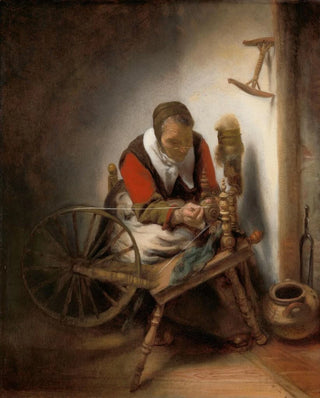Art print | De spinster - Nicolaes Maes


View from behind

Frame (optional)
In the fascinating world of 17th-century Dutch painting, the artwork "De spinster" by Nicolaes Maes stands out for its ability to capture the intimacy of a moment from everyday life. This painting, emblematic of the genre of genre painting, evokes an atmosphere filled with serenity and contemplation. Through this piece, Maes does not merely depict a young woman spinning, but invites us to immerse ourselves in her universe, to feel the significance of simple gestures and stolen moments in time. The work serves as a true window into an era when domestic life was at the heart of concerns, revealing the beauty of daily activities.
Style and uniqueness of the work
Nicolaes Maes's style is characterized by an exceptional mastery of light and shadow, a fundamental element of baroque painting. In "De spinster," the soft light illuminating the young woman's face creates a striking contrast with the surrounding shadows, thus accentuating the emotion emanating from the painting. The meticulous details, such as the thread winding around the spindle and the delicate textures of the clothing, demonstrate the attention given to each element. Maes succeeds in infusing a palpable life into his subject, making the viewer a witness to a scene that is both familiar and meaningful. The color palette, dominated by warm and earthy tones, reinforces this sense of closeness and human warmth, making "De spinster" a work of great emotional depth.
The artist and his influence
Nicolaes Maes, a pupil of Rembrandt, established himself as a master in his own right within the Dutch school of painting. Influenced by his mentor, he developed a style that combines realism and intimacy, mainly focusing on depicting scenes from daily life. Maes was able to capture the essence of his contemporaries, highlighting their everyday life with unmatched sensitivity. His influence on genre painting is undeniable, inspiring many artists who followed. Through his works, he contributed to elevating the status of genre painting, granting it legitimacy.

Matte finish

View from behind

Frame (optional)
In the fascinating world of 17th-century Dutch painting, the artwork "De spinster" by Nicolaes Maes stands out for its ability to capture the intimacy of a moment from everyday life. This painting, emblematic of the genre of genre painting, evokes an atmosphere filled with serenity and contemplation. Through this piece, Maes does not merely depict a young woman spinning, but invites us to immerse ourselves in her universe, to feel the significance of simple gestures and stolen moments in time. The work serves as a true window into an era when domestic life was at the heart of concerns, revealing the beauty of daily activities.
Style and uniqueness of the work
Nicolaes Maes's style is characterized by an exceptional mastery of light and shadow, a fundamental element of baroque painting. In "De spinster," the soft light illuminating the young woman's face creates a striking contrast with the surrounding shadows, thus accentuating the emotion emanating from the painting. The meticulous details, such as the thread winding around the spindle and the delicate textures of the clothing, demonstrate the attention given to each element. Maes succeeds in infusing a palpable life into his subject, making the viewer a witness to a scene that is both familiar and meaningful. The color palette, dominated by warm and earthy tones, reinforces this sense of closeness and human warmth, making "De spinster" a work of great emotional depth.
The artist and his influence
Nicolaes Maes, a pupil of Rembrandt, established himself as a master in his own right within the Dutch school of painting. Influenced by his mentor, he developed a style that combines realism and intimacy, mainly focusing on depicting scenes from daily life. Maes was able to capture the essence of his contemporaries, highlighting their everyday life with unmatched sensitivity. His influence on genre painting is undeniable, inspiring many artists who followed. Through his works, he contributed to elevating the status of genre painting, granting it legitimacy.






